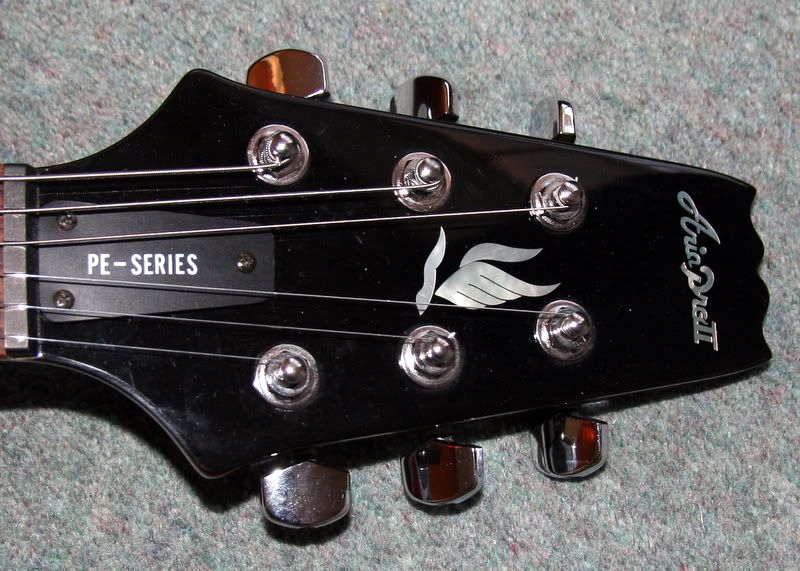
Oct 19, 2011 I did buy an ES-335 Aria copy without a serial last year that reportedly was a custom-ordered japanese made guitar from 1989. After taking it apart and asking friends, we came to the conclusion it was probably Terada made.
I had actually already stumbled onto those links, but as you say, it's far from complete. Seems like a lot of information on certain models may be permanantley lost to History. The neck plate is clearly stamped made in Japan, with the serial number, which places this guitar's production year in 1980, at least according to the bit of info I found regarding interpretation of the Matsumoku serial numbers. I guess the only thing missing in my search for information, is the Model no. And any info (if available) regarding the unique headstock.
But appears I may never learn. Thanks for the info. My first guitar in 1991 was an MIJ Aria Pro II Viper Series VP-60, a Strat or Ibanez RG type guitar. It had tail wing inlays, blue sunburst with a light flame maple top. It also had 4 single coils with 2 single coils at the bridge slanted like the Strat's bridge pickup to make a humbucker. Kinda like the Gibson nighthawk's humbucker but without the ring, and they are actually 2 single coils.

I wasn't looking for Strat or single coil sound at the time so I replaced the 2 single coil pickups on the bridge with a Duncan distortion humbucker. I regrettably had to let that guitar go It was a nice guitar, I miss it. Click to expand.Hello Ohjay! It´s the typical export-headstock. For Les Paul copies Aria has used three variations of the headstock. These were the 'open book', the 'camel hump' and the 'export version'.
The 'open book' variant was not (with a few exceptions from the early days) officially available outside of japan. For export models (outside of japan) the 'camel hump' variant was used (as far as I know) only in 1977, and the 'export version' variant from 1978 to early 1980. BTW: I own two LS-700 with the export-headstock, which I bought here in Germany in the late 70's, and I can´t remember, that I´ve ever have seen here a different variant than the 'camel hump' or the 'export version' at official store sales.
Click to expand.100% MIJ. Has the 'batwing' headstock used for the PE-series(and some others at certain periods). Not the most high-end model you can find, but being a leftie you'll be hard pressed to find something higher. Very few models were available to be ordered as lefties. Haven't personally tried anything lower than a PE-1000(of the prototype series), but word of mouth is that all PE guitars are quite good. Oh and yeah, definitely an '81. And $400 is a decent price, not cheap and not overly expensive either.
Hi Ive been the very proud owner of an Aria Pro II Les Paul for around 13 years but I actually know very little about it. Having come across this excellent site, Im now really interested in its history. Heres the details that I think may be useful and Ive also attached some photos (although I seem to be limited to just 5) to help with the identification.
Weight: 9.5lbs Colour: Tobacco, I guess. (There is a darkening of the colour towards the edges but Im not sure I would class this as sunburst). Body: Mahogany with arched maple top. Bindings front and back. The mahogany looks to be two slices sandwiched together and the back piece appears to be butterflied, theres certainly a line down the middle. The maple top also appears to be butterflied.
Neck: Looks like three pieces, possibly maple spine sandwiched between two strips of mahogany. Long tenon glued into the body with two additional screw fixings within the neck pickup cutout. Fingerboard: Rosewood with 22 frets and fret bindings. Large block mother of pearl inlays.
Really low action without any buzz. Hardware: Gold, good quality tuners and gold bridge and tailpiece.
All are showing some wear to the gold finish. The underneath of the tailpiece is marked with MADE IN JAPAN LP-S. I presume the LP-S stands for Les Paul Standard. The underneath of the bridge is stamped with L S BRIDGE MADE IN JAPAN.
Controls: Usual two volume, two tone. Gold coloured Speed Knobs. 500kohm pots mounted on a circuit board. Usual Les Paul type 3 position switch. Headstock: Not the open book style, it is more dome shaped.
Bindings to front. 3 screw truss rod cover. Split diamond motif, although this differs from the diamond motifs on the other Aria Pro II Les Pauls that Ive seen online. No serial number anywhere on this guitar. Pickups: Black Humbuckers of unknown make.